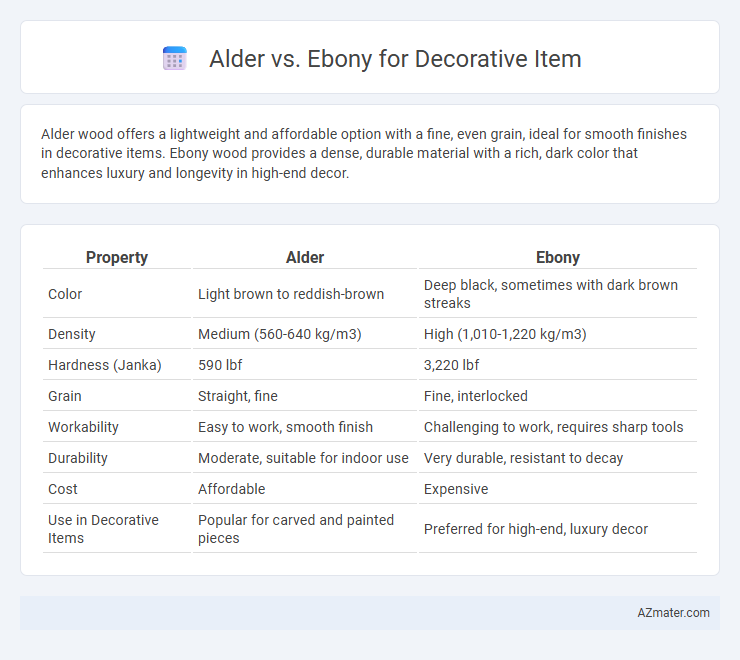Alder wood offers a lightweight and affordable option with a fine, even grain, ideal for smooth finishes in decorative items. Ebony wood provides a dense, durable material with a rich, dark color that enhances luxury and longevity in high-end decor.
Table of Comparison
| Property | Alder | Ebony |
|---|---|---|
| Color | Light brown to reddish-brown | Deep black, sometimes with dark brown streaks |
| Density | Medium (560-640 kg/m3) | High (1,010-1,220 kg/m3) |
| Hardness (Janka) | 590 lbf | 3,220 lbf |
| Grain | Straight, fine | Fine, interlocked |
| Workability | Easy to work, smooth finish | Challenging to work, requires sharp tools |
| Durability | Moderate, suitable for indoor use | Very durable, resistant to decay |
| Cost | Affordable | Expensive |
| Use in Decorative Items | Popular for carved and painted pieces | Preferred for high-end, luxury decor |
Introduction to Alder and Ebony in Decorative Items
Alder wood, known for its fine grain and light reddish-brown hue, provides a smooth finish ideal for decorative items that require a subtle, natural look. Ebony, prized for its dense texture and deep black color, offers a striking contrast and luxurious appearance in high-end ornamental pieces. Both woods are favored in decorative crafts for their durability and distinctive aesthetic qualities.
Key Characteristics of Alder Wood
Alder wood is prized for its fine, straight grain and smooth texture, making it an excellent choice for decorative items that require detailed carving and a uniform finish. It is a lightweight hardwood with moderate durability, offering good workability and a warm, reddish-brown hue that deepens with age. Compared to ebony, which is denser and darker, alder provides a softer, more approachable aesthetic ideal for intricate designs and cost-effective projects.
Key Characteristics of Ebony Wood
Ebony wood is prized for its deep black color and exceptional density, making it highly durable and resistant to wear for decorative items. Its fine, smooth texture allows for intricate carvings and a polished finish that enhances aesthetic appeal. Compared to alder, ebony's hardness and natural luster provide a luxurious and long-lasting option for upscale decorative pieces.
Aesthetic Appeal: Alder vs Ebony
Alder wood offers a warm, light brown hue with subtle grain patterns that create a rustic yet refined aesthetic ideal for decorative items in cozy or traditional interiors. Ebony, known for its deep, jet-black color and fine texture, delivers a striking, luxurious contrast perfect for modern, high-end decorative pieces. Choosing between Alder and Ebony depends on whether the desired look is natural and inviting or bold and sophisticated.
Durability and Longevity Comparison
Alder wood offers moderate durability with a softer texture prone to dents and scratches, making it less ideal for high-traffic decorative items, whereas ebony is known for its exceptional hardness and resistance to wear, ensuring longer-lasting beauty. Ebony's dense, oily grain resists moisture and decay effectively, providing superior longevity compared to the more susceptible alder. For decorative items requiring enduring strength and minimal maintenance, ebony presents a significantly more durable and long-lasting choice.
Workability and Crafting Differences
Alder wood offers excellent workability due to its soft texture and consistent grain, making it easy to carve, shape, and finish for detailed decorative items. Ebony, known for its dense, hard structure, presents challenges in crafting but provides superior durability and a polished, high-contrast finish that enhances intricate designs. Crafting with alder is faster and more forgiving, while ebony requires specialized tools and skill to avoid splitting and to achieve its signature smooth surface.
Cost and Availability Insights
Alder wood is generally more affordable and widely available, making it a popular choice for decorative items that require budget-friendly materials without sacrificing quality. Ebony, known for its dense, dark appearance, commands a higher price due to its rarity and slower growth, limiting its availability in the market. The cost disparity between alder and ebony often guides consumer preference, with alder favored for cost-effectiveness and ebony selected for premium, luxury decor pieces.
Environmental Impact and Sustainability
Alder wood, sourced from fast-growing trees, offers a more sustainable option for decorative items due to its rapid regeneration and lower environmental footprint compared to ebony, which is often harvested from slow-growing, endangered species. Ebony's extraction contributes to deforestation and biodiversity loss, making it less environmentally friendly and subject to trade restrictions under CITES regulations. Choosing alder supports sustainable forestry practices and reduces ecological damage while providing a visually appealing alternative for decorative purposes.
Popular Decorative Uses for Alder and Ebony
Alder wood is favored for decorative items such as carved sculptures and rustic furniture due to its soft texture and warm reddish-brown hue, which easily accepts stains and paints for custom finishes. Ebony is prized in decorative uses like inlays, musical instrument veneers, and luxury ornamental pieces because of its dense, jet-black appearance and natural luster that create striking contrast and elegance. Both woods serve distinct aesthetic purposes, with alder offering versatile coloration and workability, while ebony provides durability and a high-end, polished look.
Choosing the Right Wood for Your Decorative Item
Alder wood offers a smooth texture and warm, reddish-brown hue, making it ideal for decorative items that require a subtle yet elegant appearance. Ebony, known for its dense, dark, and luxurious finish, provides a striking contrast and durability but comes at a higher cost and weight. When choosing the right wood for your decorative item, consider the desired aesthetic, budget constraints, and the wood's workability and longevity to ensure the final piece meets both functional and visual expectations.

Infographic: Alder vs Ebony for Decorative Item
 azmater.com
azmater.com